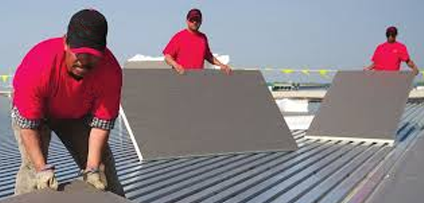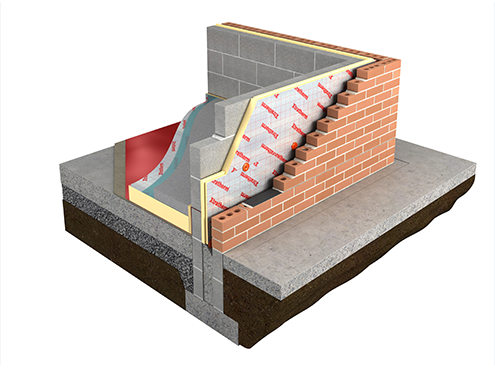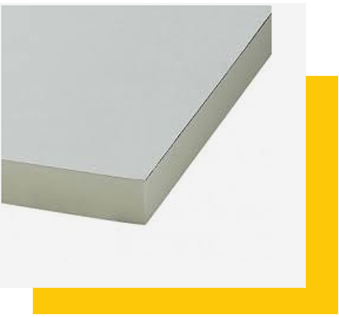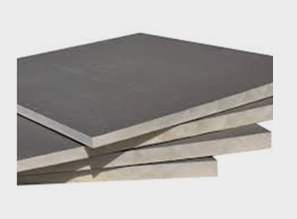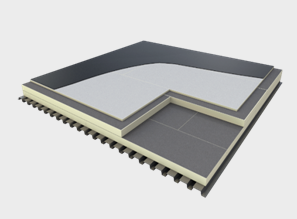DuraTherm R-5.0™ Polyisocyanurate Boards for Building Insulation
Saving energy in buildings becomes more important every day. Today, nearly 40 percent of our nation’s energy is used to heat, cool and operate our homes and buildings. Energy lost through walls, roofs and windows is the largest single waste of energy in most buildings. Energy loss in buildings means extra operating costs, loss of comfort, and reduced productivity. When it comes to energy efficiency in buildings, polyisocyanurate foam insulation (PIR) is at the centre of the discussion. It’s because they are some of the most efficient thermal insulating products for buildings. They work to reduce heating and cooling loss, improving the efficiency of the building envelope.
DuraTherm R-5.0™ PIR Board is a thermoset plastic produced as a foam and used as rigid thermal insulation. The starting materials are similar to those used in polyurethane (PUR) except that the proportion of methylene diphenyl diisocyanate (MDI) is higher and a special polyester-derived polyol is used in the reaction instead of a polyetherpolyol. The resulting chemical structure is significantly different, with the isocyanate groups on the MDI trimerising to form isocyanurate groups which the polyols link together, giving a complex polymeric structure.
DuraTherm R-5.0™ PIR Board insulation is used successfully as foundation, wall, and roof insulation in both commercial and residential establishments.DuraTherm R-5.0™ PIR Insulation is shaped as an insulated panel, typically consisting of a Polyisocyanurate Board that forms a rigid foam core, laminated on one or both sides with foil, fibre-reinforced felt, or coated-glass facers.
DuraTherm R-5.0™ R-5.0™ PIR Board, has one of the highest R-Value per inch of commercially available insulation products. Typical R-Values range in excess of 5.7 per inch allows for energy efficient design featuring thin walls and low profile roofs. This allows the architect or engineer to maximise the usable space in a building while reducing operating costs. Whereas a properly insulated building can save up to 20% heating and cooling costs, energy efficiency impacts more than operating costs. Highly efficient Walls and Roofs may allow heating and cooling equipment to be downsized by as much as 35% while potentially offering more floor space for the same unit price.
- Conforms to ASTM C-1289 “Standard Specification for Faced Rigid Cellular Polyisocyanurate Thermal Insulation Board
- A high R-value per inch of thickness when compared to other insulation products.
- A moisture-resistant foam core.
- Compatibility with most solvents used in construction adhesives.
- Excellent dimensional stability.
- Excellent performance in fire tests – DuraTherm R-5.0™ can meets the strict standard of both FM Class 1 Approvals (FM 4450/4470)**& UL 1256**.
- A wide range of service temperatures.
- Long Term R-value (only roof insulation with third party certification).
- A CFC- and HCFC-free product with Zero Ozone Depletion Potential (ODP).
- Negligible global warming potential.
- Availability throughout India
DuraTherm R-5.0™ Roof Insulation Boards:
Roof insulation is a critical component of a roof system and contributes to overall building energy efficiency as the roof is the largest single side of a typical building. Recognizing the importance of an energy-efficient building thermal envelope, modern energy codes establish minimum requirements for insulation installed entirely above the roof deck.
DuraTherm R-5.0™ insulation is the efficient product for low-slope commercial roofing and provides a high R-value that helps meet today’s energy code requirements without the added thickness or weight of other products. DuraTherm R-5.0™ is suitable for both new and roof replacement systems due to PIR’s numerous performance advantages, which include:
- Excellent fire performance (approved for direct to steel deck attachment)
- Compatibility with a wide-variety of roof systems
- Low global warming potential blowing agents
DuraTherm R-5.0™ Continuous Wall Insulation:
Continuous insulation provides improved performance compared to typical cavity insulation by creating an uninterrupted thermal barrier across the wall. The unparalleled performance of continuous insulation results from the reduction of thermal bridges created by wall framing members. Continuous insulation also can serve as a water resistant barrier and air barrier.
DuraTherm R-5.0™ delivers a high R-value when compared to other products, which allows for designed thermal performance to be achieved with a minimum thickness of insulation. DuraTherm R-5.0™ can be installed as a 3-in-1 building envelope solution to meet water resistant and air barrier requirements. Other benefits of DuraTherm R-5.0™ for Wall Insulation include:
- Excellent fire performance
- Reduced risk for water vapour condensationand moisture accumulation in the wall
- Durable; lightweight; ease of installation
- Low global warming potential blowing agents
DuraTherm R-5.0
™ – Residential Wall Construction
Continuous insulation provides improved performance compared to typical cavity insulation by creating an uninterrupted thermal barrier across the wall. The unparalleled performance of continuous insulation results from the reduction of thermal bridges created by wall framing members. Continuous insulation also can serve as a water resistant barrier and air barrier.
DuraTherm R-5.0
™ continuous insulation for residential construction is typically manufactured with a foil-facer that delivers a high R-value compared to other product types. This performance allows builders to meet today’s energy code requirements for highly energy efficient homes with a minimum thickness of insulation. To reduced installed cost and deliver additional homeowner benefits, DuraTherm R-5.0™ can be installed as a 3-in-1 building envelope solution to meet water resistant and air barrier requirements. Other benefits of DuraTherm R-5.0™ for residential construction include:
- Excellent fire performance (DuraTherm R-5.0™ does not melt or drip when exposed to flame)
- Reduced risk for water vapour condensation and moisture accumulation in the wall
- Lower construction costs with 3-in-1 barrier performance
- Versatile performance for above and below-grade wall applications
High-Density (HD) DuraTherm R-5.0™ Roof Cover Board
Roof cover boards are an important component in any roof assembly to provide a suitable substrate for the attachment of a membrane and enhance the overall durability of the roof system. Cover boards protect the underlying insulation from roof traffic and can allow the roof area to be used for installation of renewable energy systems such as rooftop PV.
HD DuraTherm R-5.0™ roof cover boards provide the protection of traditional material options with the added performance of thermal insulation. This means the cover board can be combined with DuraTherm R-5.0™ roof insulation to meet energy code requirements for new and roof replacement systems.
Other advantages of HD DuraTherm R-5.0™Standard R roof cover boards include:
- Lightweight for installation efficiencies
- Superior water resistance
- Easy to cut (no special tools required)
- Virtually dust free
- Excellent impact resistance
- Mold resistance
- Long-term durability
DuraTherm R-5.0™ Continuous Wall Insulation:
All construction materials, including foam plastic materials like DuraTherm R-5.0™ insulation, must provide a suitable margin of fire safety. Codes and test standards set the minimum level of overall building fire safety as well as minimum levels of fire performance for specific construction materials and assemblies. These codes and standards are developed and maintained through consensus-based processes. Groups of experts and other stakeholders that include representatives beyond product manufacturers contribute to the various code and standard development processes.
DuraTherm R-5.0™ insulation delivers a high level of inherent fire resistance when compared to other foam plastic insulations due to its unique structure of strong isocyanurate chemical bonds. These bonds result in improved high temperature resistance (up to 190 degrees C; more than twice the temperature resistance of other building insulation foams) which in turn leads to enhanced fire resistance. In addition, DuraTherm R-5.0™ products form a protective surface char when exposed to a sufficient flame source. This physical property is exhibited in the ASTM E84 or “Steiner Tunnel” test, where DuraTherm R-5.0™ insulation test specimens remain intact (i.e., do not melt or drip) during the test’s fire exposure. This performance characteristic further enhances DuraTherm R-5.0™’s fire resistance, especially in terms of flame spread and flashover potential.
Roofing Applications
Commercial roofs are subjected to full assembly fire testing; individual material components like DuraTherm R-5.0™ insulation are required to meet additional product-specific fire performance criteria. DuraTherm R-5.0™ remains the only foam plastic insulation product for direct application to steel roof decks to earn FM Approval for Class 1 Roof Systems. An FM Class 1 designation means the roof assembly has been subjected to a series of tests in addition to external and internal fire exposure, including wind uplift, water leakage and impact resistance. As a result, direct-to-deck assemblies containing DuraTherm R-5.0™ insulation meeting NFPA 276 (FM 4450)** or UL 1256** can be installed without a thermal barrier.
Wall Applications
Exterior walls of any height on commercial buildings (IBC Types I-IV) that contain DuraTherm R-5.0™ insulation (or any other foam plastic insulation) must be evaluated for full-assembly fire performance per NFPA285**. Foam plastic insulation products are also required to meet additional product-specific fire performance criteria for flame spread and smoke development. DuraTherm R-5.0™’s exceptional fire performance provides building designers with important flexibility when selecting other components of exterior wall systems, including façade or cladding materials. A wide-variety of exterior wall assemblies that combine DuraTherm R-5.0™ insulation with MCM panels, brick and other popular materials have passed the rigorous, two-story NFPA 285 fire test. Note: Wall systems containing DuraTherm R-5.0™ insulation may be subject to other fire tests and building code requirements. Consult your local building code and manufacturer installation instructions for more details.
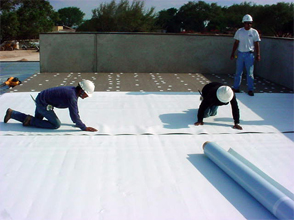

DuraTherm R-5.0™ and Flame Retardants
DuraTherm R-5.0™ insulation possesses a high level of inherent fire resistance due to its unique structure of strong isocyanurate chemical bonds. Manufacturers further enhance the fire resistance of DuraTherm R-5.0™ by adding flame retardant materials to the product formulations. The end result is an insulation product that meets the demands of modern fire codes.
The term “flame retardant” refers to a function, not a family of chemicals. In general, flame retardants are materials that can be used in products to reduce the chances of a fire starting and to delay the spread of fire.
The common flame-retardant chemical used in DuraTherm R-5.0™ products is TCPP [tris (2-chloro-1-methlyethyl) phosphate]. TCPP is a well-studied chemical for any known health and environment effects, and was selected by the industry to provide an additional level of fire resistance to DuraTherm R-5.0™ products.
Importantly, materials used to provide flame retardant properties in building insulation and other products are not equal. With respect to additive, nonpolymericorganohalogen flame retardants, a recent report by the National Academy of Sciences concluded that individual hazard assessments are required in order to accurately characterize each substance. In other words, organohalogen flame retardants cannot be treated as a class of chemicals for purposes of hazard evaluation.
Not a Chemical of Concern
TCPP is not classified as a chemical of concern by any authoritative global or national authority, including the European Chemicals Agency (ECHA), the U.S. Environmental Protection Agency (EPA), and prominent state authorities such as the California Office of Health Hazard Assessment (OEHHA) and the Massachusetts Toxics Use Reduction Administrative Council (TURA). Based on the best available scientific studies, including a comprehensive risk assessment completed by ECHA in 2008, TCCP is not considered to be toxic or bio accumulative, and its environmental persistence is lower than other common chemicals.
With respect to the 2008 risk assessment study, ECHA concluded that there was "no concern” to consumer health risks based on measured margins of safety ranging from a low of 667 to a high of 395,000 times anticipated exposure levels. In the case of foam plastic building insulation, the ECHA study concluded that indoor insulation risks were assumed to be so negligible that they were not included in the final risk characterization phase of the study.
No Identified Environmental Risks
The 2008 ECHA risk assessment for TCPP provides exhaustive documentation regarding the environmental performance of TCPP. In regard to environmental risks associated with TCPP, the study found no identified risks to the environment, including freshwater and marine aquatic, soil (with any life cycle stage), and atmospheric.
Source: European Union Risk Assessment Report for TCPP (May 2008).
Energy Codes
Building energy codes and standards set minimum energy efficiency requirements for the design and construction of new and renovated buildings in order to reduce energy use and related greenhouse gas emissions over the useful life of buildings. Included within the codes and standards are minimum requirements for thermal insulation installed as part of the building envelope (i.e., roof, above-grade walls, below-grade walls, and below slab).
The International Energy Conservation Code (IECC) and ASHRAE Standards 90.1 and 90.2 are the most widely adopted energy codes, translated / adapted in India. Specifically, these documents regulate energy efficiency for the building thermal envelope by establishing minimum requirements for thermal insulation and air leakage. Importantly, while the IECC is more frequently adopted by jurisdictions, this code recognizes ASHRAE 90.1 (commercial buildings) and 90.2 (residential buildings) as alternative compliance options.
International Green Construction Code (IgCC): This green code provides the design and construction industry with a single, effective way to deliver sustainable, resilient, high-performance buildings. The 2018 IgCC provides synergies with ASHRAE-developed standards as well as the LEED rating system.
National Green Building Standard: Developed as ICC/ASHRAE 700, the National Green Building Standard certification provides independent, third-party verification that a home, apartment building, or land development is designed and built to achieve high performance in six key areas, including energy efficiency.
Leadership in Energy and Environmental Design (LEED): As the most widely used green building rating system in the world, the LEED rating system provides a framework to create healthy, highly efficient, and cost-saving green buildings.
Leadership in Energy & Environmental Design (LEED) Green Building Rating System® was developed to measure the environmental impact of constructing a building. IGBC has brought most sectors of the building industry together to develop a voluntary, national benchmark for "high-performing, sustainable buildings." The LEED Rating System establishes basic requirements for the various aspects of sustainable design:
- Sustainable Sites
- Water Efficiency
- Energy and Atmosphere
- Materials and Resources
- Indoor Environmental Quality
- Innovation and Design Process
- Credits or points are earned for meeting the requirements of the specific LEED rating category. A threshold of 40 percent of the available points is required to achieve the minimum LEED Certified rating. Higher performance levels are designated as Silver, Gold or Platinum and are achieved by meeting minimum points for each level.
DuraTherm R-5.0™ To achieve Credits under the LEED rating system:
Using DuraTherm R-5.0™ insulation may help achieve credits under the LEED rating system. Here are some suggested opportunities to incorporate DuraTherm R-5.0™ in a building design using LEED for new construction and major renovations (Version 3):
Energy & Atmosphere
Energy & Atmosphere
- Minimum Energy Performance: Prerequisite 2
Thermally efficient DuraTherm R-5.0™ facilitates compliance with ASHRAE 90.1-2007 and local energy codes.
- Optimize Energy Performance: Credit 1
DuraTherm R-5.0™ provides the highest thermal resistance per inch of material and can economically contribute to achieving one of the LEED levels of optimized energy performance.
Materials & Resources
- Construction Waste Management: Credit 2If the total percentage of reused materials in a project does not meet the minimum levels stated in Materials and Resources, Credit 1, Building Reuse, these reuse activities may be applied to this credit.
- Materials Reuse: Credit 3DuraTherm R-5.0™ can be reused in order to reduce demand for virgin materials and reduce waste. Recycled Content: Credit 4Depending on the product, DuraTherm R-5.0™ can be used toward one of the levels of recycled materials credit.
- Local/Regional Materials: Credit 5DuraTherm R-5.0™ manufacturing facilities are located in India. Therefore, the use of DuraTherm R-5.0™ may contribute towards gaining this credit, depending on the version of LEED being used as the basis of design.
- Rapidly Renewable Materials: Credit 6 Depending on the product composition, and thickness, DuraTherm R-5.0™ can be used toward one of the levels of rapidly renewable materials credit.
- Certified Wood: Credit 7 FSC-certified wood when used in products where DuraTherm R-5.0™ is bonded to the wood can contribute to gaining this credit.

Green building codes in india :
In India, the Green Building Code is a medley of codes and standards contained in the State by-laws, the National Building Code, the Energy Conservation Building Code (ECBC) and in the norms set by the ratings programmes, such as Leadership in Energy and Environmental Design-India (LEED-India), the standards and guidelines put down for the Residential Sector by the Indian Green Building Council (IGBC), TERI-GRIHA and other such certifications. Basic and general guidelines for efficient energy usage in the National Building Code (NBC) do exist but they are merely guidelines.




